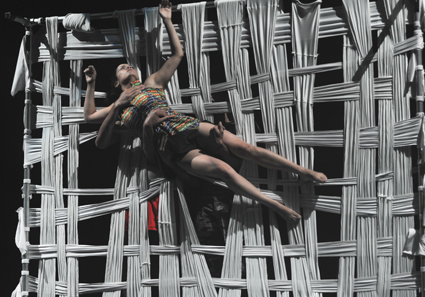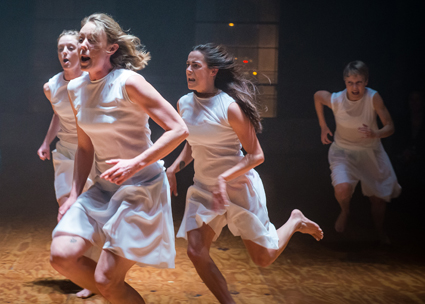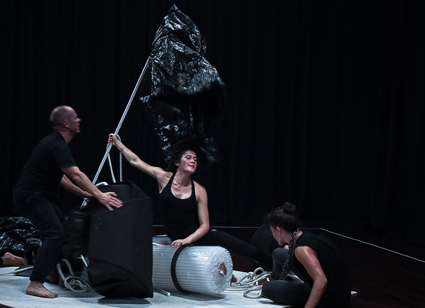Up there for dancing
Keith Gallasch, Dance Massive & Long Grass

Long Grass, Vicki Van Hout
photo Heidrun Löhr
Long Grass, Vicki Van Hout
Vicki Van Hout’s Long Grass in the 2015 Dance Massive, the fourth of these two-week festivals of innovative Australian dance, follows the appearance of Marrugeku’s Gudirr Gudirr (RT114), a cross-cultural collaboration featuring dancer-choreographer Dalisa Pigram in the 2013 program. Together they signal that contemporary Indigenous dance is becoming both more visible and aesthetically and culturally diverse.
The programming of Indigenous dance has not been easy for Dance Massive given the dominance of Bangarra Dance Theatre (with whom Van Hout has danced) and a paucity of works elsewhere. Pigram (see interview) and Van Hout are changing this, while the emerging TSI choreographer Ghenoa Gela (whose work appeared at last year’s Next Wave and in Force Majeure’s developmental workshop season Cultivate and who inventively choreographed the finale of that company’s Nothing to Lose; see review) represents the promise of works to come.
Long Grass
Van Hout is at once auteur and collaborator—her vision and choreography are exquisitely distinctive, her creations woven through collaboration. She’s an integrator, drawing on the many Indigenous dance practices people have shared with her across Australia and her fellow artists’ ideas and experiences. (She is also a formidable writer, blogging enthusiastically and insightfully for Western Sydney’s FORM Dance Projects. The Aboriginal English dialogue in Long Grass is witty and revealing). For Long Grass she invited Darwin dancer-choreographer Gary Lang (whose long established work needs to be seen beyond that city) to work with her as cultural consultant and co-choreographer. Van Hout, with Lang and lighting designer Clytie Smith, created the ring of tall grass, representing the vacant land where homeless and displaced Aboriginals (called “long grassers”) gather in Darwin. True to the work’s ambivalence about Long Grass culture—at once violent and communal—the tall grass catches the light, sparking in a bleak world. Close inspection reveals the stems and flowerings to be intricately crafted—the knotting and weaving, hours of labour—the kind of detail also evident in Van Hout’s design for her first major work, Briwyant in 2011 (RT103).
A sculptural design centrepiece is of another kind of weave: a bed frame with a mattress support woven from long strips of material by the performers: it symbolises rest, intimacy, sensual seduction, entrapment and boundaries as it cradles and entangles dancers and is deftly manoeuvred about the stage framing action (see the cover of this edition).
The action is discursive; a series of vignettes of Long Grass life played with a laidback naturalism, recorded and live voice-overs (Lang), songs and eruptions of dance. This is dance theatre that really dances; the great power and precision of the highly articulated movement contrasts painfully with Long Grass inertia—drugged states and the incapacities of old age (a funny but finally sad motif). The forceful dancing represents the creative potential of joyous communality, too often distorted into sexual competition and violence—a woman beaten by one man immediately becomes target for another in a harrowing sequence, all the more ugly for its meticulous crafting. The dancers are uniformly superb in solos, duets and groups, Van Hout realising dance for the men with a rich variety of articulation and inflection. Only occasionally does the structure and tempo of Long Grass falter (a drunken night-on-the-town trio) or suggest that it’s too discursive.
Long Grass is an important work, culturally, sociologically and aesthetically, revealing in observant detail the lives of the dispossessed with humour, bitterness and sadness. It’s a brave work: not everyone will be able to reconcile the portrayal of hopelessness with Long Grass’s inherent optimism: a fraught community with ancient if damaged roots is better than none. Not least, it is the fine weave of dance, drama and music, resonant with the design, that makes Long Grass at once tautly and casually cogent, with dance writing hope large upon the stage and on our psyches.

Sarah Aiken, Rebecca Jensen, Rachel Coulson, Janine Proost, Overworld
photo Gregory Lorenzutti
Sarah Aiken, Rebecca Jensen, Rachel Coulson, Janine Proost, Overworld
2015 Dance Massive
Once again Dance Massive is very largely a Victorian affair, with NSW (Force Majeure, Vicki Van Hout, Sue Healey) being the only other state represented this year. Given the paucity of major dance festivals around Australia (save for Perth’s new MoveMe Dance Improvisation Festival, see reviews by Maggi Philips & Nerida Dickinson), Australia Council investment in the event and the National Dance Forum occurring in Melbourne at the same time, interstate artists must be wondering about their standing, let alone their careers, as Dance Massive markets programmed works by bringing in international producers and presenters.
The willingness and courage of Arts House, DanceHouse and Malthouse to commit so consistently to Dance Massive is admirable and doubtless there are advantages in showcasing local works already funded and which do not require expensive transport costs to mount in an already dance-dense culture. Artists and companies from other states might not be ready to fit the Dance Massive two-year cycle or the costs to participate might be beyond them. Whatever the reason, Dance Massive looks like a festival for and by Melbournians when it should be more than that.
Massive themes
The body-machine nexus continues to enthral choreographers much more than it does playwrights and theatre directors. In dance, the authentic body is at stake; as new technologies become more pervasive, providing electronic and mechanical prostheses and robotic substitutes, choreographers envisage co-option, cooperation or defeat. Antony Hamilton and Alisdair Macindoe in Meeting “share space with 64 robotic percussion instruments… the bodies enter[ing] states of heightened physical and mental agency, with all actions carried by the meditative pulse of the machine beat.” Rebecca Jensen and Sarah Aiken’s Overworld, “inspired by our immediate and unlimited capacity to access pop culture just as easily as ancient ritual and spiritual practice,” assays “how we access and broadcast information online, how we connect to information and to each other, what is meaningful and what is not” (see review from Next Wave 2013). Atlanta Eke (see review of recent work at Alaska Projects) performs Body of Work in which the human is “a biological organism and technical machine; a cyborg blurring the lines between who choreographs and who is choreographed.” In Stampede the Stampede, Tim Darbyshire performs “within a turbulent yet controlling choreographic apparatus…. the work attempts to expand choreography by means of machinery, object, lighting and sound configurations.”
In Motion Picture, Lucy Guerin looks to an older media technology that is still potently with us, taking “the 1950 film noir classic D.O.A. as a choreographic score to explore the tensions between live performance and cinema.” Rudolf Maté’s movie is screened behind the audience, but seen and interpreted by the dancers—who or what choreographs here, film or Guerin? As with our relationship with new technologies, this work “both pays homage to the moving image and rebels against it.”

Merge, Melanie Lane, Dance Massive
photo Dian McLeod
Merge, Melanie Lane, Dance Massive
Connectivity in terms of space and materiality is explored in a number of Dance Massive works. Rosalind Crisp engages with design (and the talents of Helen Herbertson and Ben Cobham) in The Boom Project while Melanie Lane in Merge relates to objects created by visual artists Bridie Lunney and Ash Keating. Prue Lang’s SpaceProject “is the investigation of movement through the perception of space.” Chunky Move’s Depth of Field (a term long associated with filmmaking in respect to lenses and perception of space) breaks out of the theatre into public space in order “to reveal the unseen in the everyday.” Shelly Lasica’s Solos for Other People is performed in a basketball gym and Natalie Abbott’s Maximum conjures the gym inside a theatre.
A different kind of space is entertained in BalletLab’s Kingdom, where “four men—poof, queer, homo, fag—who also happen to be choreographers, come together to articulate how their individual and collective desires intersect with art, life and sexuality.” The dancer-choreographers “penetrating each other’s artistic territories,” are Matthew Day, Luke George, Rennie McDougall and Phillip Adams working in close collaboration with visual artist Andrew Hazewinkel to explore “ideas of utopia and a relationship to habitation, nature and identity.”
The body itself is the subject of Force Majeure’s Nothing to Lose, a bracing entertainment in which proudly corpulent artists stare down prejudice, enact favourite performances and dance gloriously. Rawcus’ ensemble of artists with and without disabilities likewise aims to reveal the potential of marginalised bodies and lives: “From karaoke to bedroom dancing and imagined celebrity, 12 performers grace eight stages side-by-side in a tableau that becomes an exhibition of human expression.” In Do You Speak Chinese? non-Chinese speaking Melbournian Victoria Chiu “plays with the many ways our bodies speak for us, often before we’ve even had a chance to open our mouths,” and in 10,000 Small Deaths, Paula Lay foregrounds “the experiential body,” directly addressing with dance, video and music “the transience of our corporeality and the beauty and sadness of existence.” Sue Healey’s On View: Quintet presents portraits live and on film of Martin del Amo, Shona Erskine, Benjamin Hancock, Raghav Handa and Nalina Wait, “explor[ing] the dimensions of portraiture and how we view each other.”
The body and space, perception, identity and technology with the odd hint of transcendence and a touch of dance metaphysics: what beyond music and our inner pulse dances us? That’s Dance Massive waiting to be danced in 2015.
Arts House, Dancehouse, Malthouse, Dance Massive, 2015, Melbourne, 10-22 March
RealTime issue #125 Feb-March 2015 pg. 19






